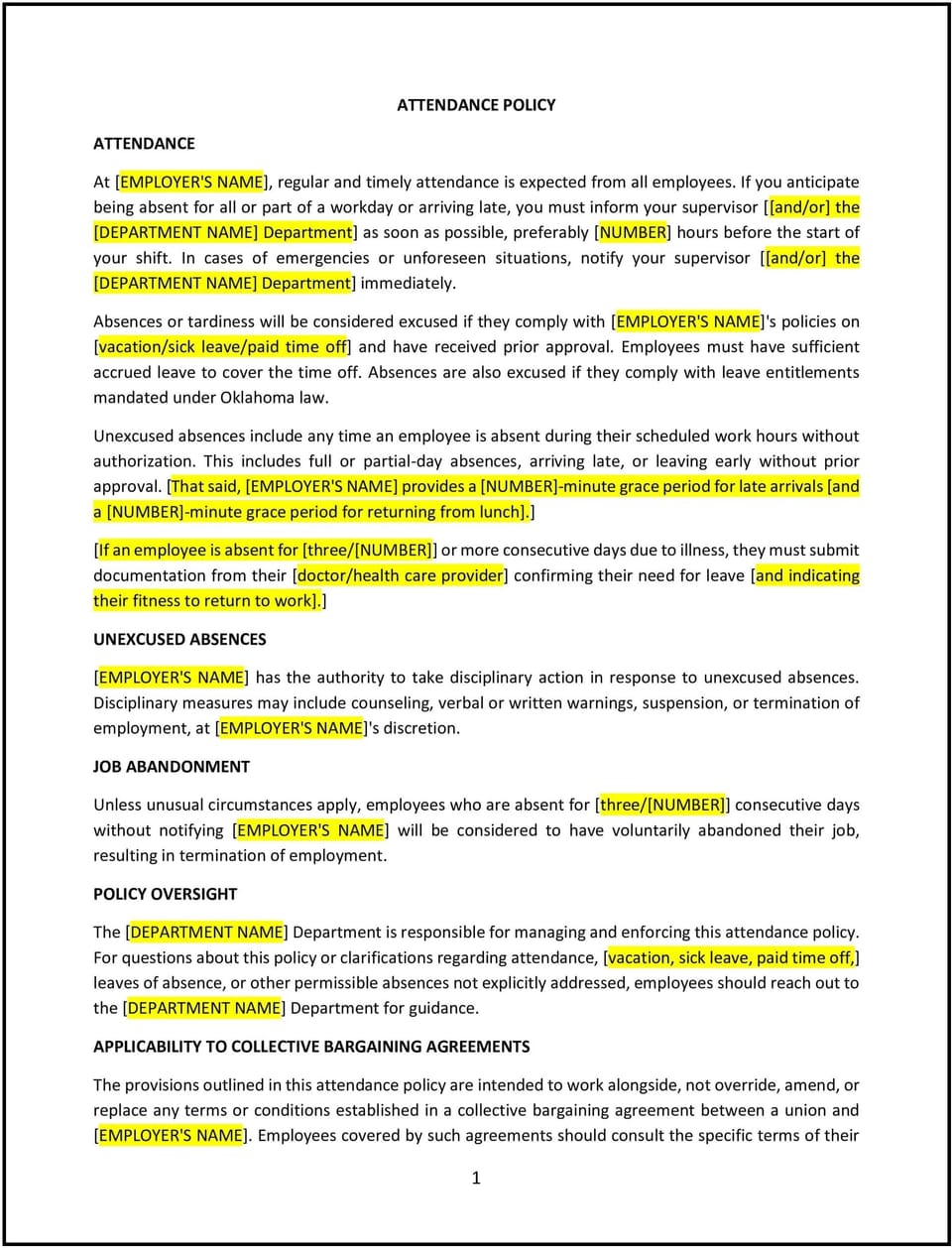Attendance policy (Oklahoma): Free template

Attendance policy (Oklahoma)
This attendance policy is designed to help Oklahoma businesses establish clear expectations for employee attendance and punctuality. It outlines procedures for reporting absences, managing time-off requests, and addressing attendance issues.
By adopting this policy, businesses can maintain productivity, ensure fair treatment of employees, and promote accountability.
How to use this attendance policy (Oklahoma)
- Define expectations: Clearly explain the business’s expectations for attendance and punctuality, including work hours and break times.
- Establish reporting procedures: Provide steps for employees to report absences or tardiness, including required notice and documentation.
- Outline time-off requests: Describe the process for requesting time off, such as vacation, sick leave, or personal days, and how approvals are determined.
- Address attendance issues: Specify the steps for addressing chronic absenteeism or tardiness, such as verbal warnings or written notices.
- Train managers: Educate supervisors on enforcing the policy consistently and handling attendance issues fairly.
- Review and update: Assess the policy annually to ensure it aligns with evolving business needs and employee expectations.
Benefits of using this attendance policy (Oklahoma)
This policy offers several advantages for Oklahoma businesses:
- Maintains productivity: Ensures consistent attendance, reducing disruptions and maintaining workflow.
- Promotes fairness: Provides clear guidelines for attendance, ensuring all employees are treated equally.
- Enhances accountability: Encourages employees to take responsibility for their attendance and punctuality.
- Reduces conflicts: Addresses attendance issues early, preventing misunderstandings or disputes.
- Builds trust: Demonstrates a commitment to transparency and fairness in managing attendance.
Tips for using this attendance policy (Oklahoma)
- Communicate clearly: Ensure all employees understand the policy and their responsibilities regarding attendance.
- Provide training: Educate managers on enforcing the policy consistently and handling attendance issues fairly.
- Monitor attendance: Track attendance records to identify patterns and address issues proactively.
- Encourage communication: Foster an environment where employees feel comfortable discussing attendance concerns or requesting time off.
- Update regularly: Review the policy annually to ensure it remains effective and aligned with business needs.
Q: How does this policy benefit businesses?
A: It maintains productivity, promotes fairness, and enhances accountability in managing employee attendance.
Q: What should employees do if they need to miss work?
A: Employees should follow the reporting procedures outlined in the policy, including providing required notice and documentation.
Q: How are time-off requests approved?
A: Time-off requests are typically approved based on business needs, staffing levels, and the employee’s reason for the request.
Q: What happens if an employee has chronic attendance issues?
A: The business may address the issue through verbal warnings, written notices, or other disciplinary actions as outlined in the policy.
Q: How often should businesses review this policy?
A: Businesses should review the policy annually or as needed to ensure it aligns with evolving business needs and employee expectations.
This article contains general legal information and does not contain legal advice. Cobrief is not a law firm or a substitute for an attorney or law firm. The law is complex and changes often. For legal advice, please ask a lawyer.


